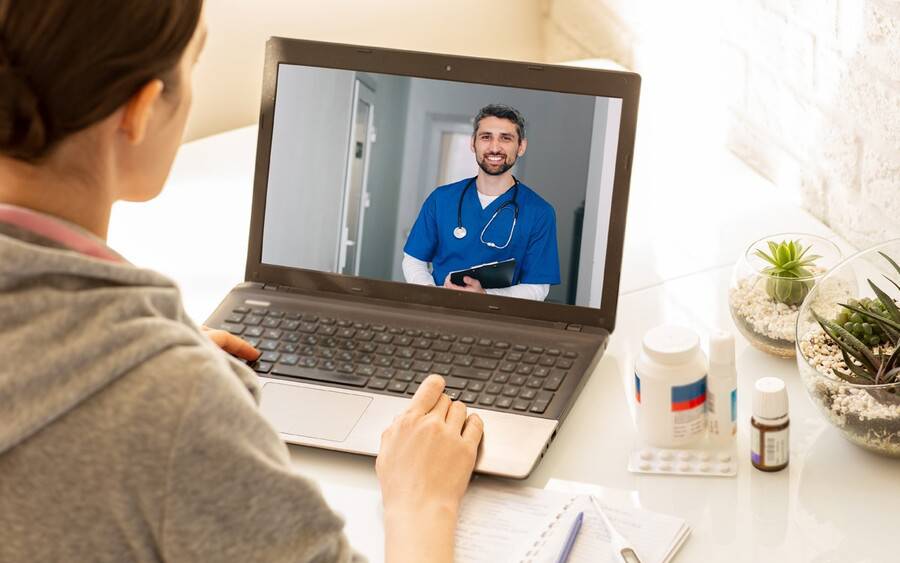How to Prepare for a Successful Video Visit with Your Doctor
Easy tips to get the most out of your virtual doctor visit

Easy tips to get the most out of your virtual doctor visit
Virtual care — also called telemedicine or telehealth — has grown rapidly and changed the way people receive health care. Video visits are now a permanent part of this change, giving patients a secure, convenient way to connect with their providers from home or wherever they have internet access.
At Scripps, video visits are used for a wide range of needs — from minor illnesses and injuries to wellness check-ins and follow-up care.
“Video visits won’t replace every visit, but where it makes sense, especially for care that doesn’t require a physical exam in person, they will continue to be a secure and convenient option for patients,” says David Wetherhold, MD, a Scripps Clinic internal medicine physician and Scripps chief medical information officer for ambulatory care.
In addition to video visits, Scripps also offers E-visits and Symptom Checker.
What is a video visit?
A video visit is a secure, real-time appointment between you and a health care provider using a smartphone, tablet or computer. It allows you to get care from the comfort of your home or wherever you have internet access.
At Scripps, video visits are done through the MyScripps patient portal, connecting you with your primary care doctor, specialist or an On-Demand provider for non-urgent needs. No special equipment is required, but tools like a thermometer or blood pressure cuff can be helpful.
Scripps also supports integration with the Apple Health app, so compatible devices like Apple Watch can automatically share health data — such as blood pressure, heart rate and glucose levels — with your care team.
When to use a video visit
Video visits are best for non-emergency health issues, including:
- Cough, cold or flu symptoms
- Skin issues or rashes
- New prescriptions or medication follow-ups
- Chronic disease management
- General wellness visits
- Other minor health conditions
If your health care provider determines you need to be seen in person, they will give you clear instructions on when to come into the office, or where to go for care.
How to book a video visit at Scripps
On-Demand Video Visits: For same-day care, log into your MyScripps account and select HealthExpress or primary care. You’ll be matched with the next available provider — no appointment needed.
Scheduled Video Visits: You can request a video appointment with your primary care doctor, specialist or HealthExpress provider through your MyScripps account, by calling your doctor’s office or at scripps.org.
Your video visit checklist
Whether it’s your first visit or you’ve had one before, a little preparation can help everything go smoothly. Here are some tips to guide you:
1. Check your internet connection
A strong connection helps prevent freezing or dropped calls. Try to sit close to your Wi-Fi box (router) for the best signal. If you’re using a laptop, you can also plug it directly into the box with a cable for an even stronger connection.
2. Find a private, quiet place
Set up in a quiet, private area, so you can discuss personal medical information. Turn off background noise from the TV, radio or music so your health care provider can hear you clearly.
3. Prepare your questions
Write down your questions and symptoms before the visit so you do not forget them. You may also want to note when symptoms began, any changes in your health and a list of current medications. Having this information ready will help your provider give you the best care.
4. Use good lighting
Sit in a well-lit area so your provider can see you clearly. Face a window or lamp when possible. Avoid sitting with your back to a light source as this will make it difficult for the provider to see you.
5. Position your device properly
Place your phone, tablet or computer on a stable surface and keep it at eye level.
If you’re using a mobile device, turn it horizontally for a wider view. Make sure your provider can clearly see your face and upper body during the visit.
6. Get camera help if needed
Your provider may ask you to adjust the camera to get a better view of a symptom or body part. If it’s hard to hold the device and follow instructions at the same time, don’t hesitate to ask a family member or caregiver to help.
7. Test your device and sound
Before your appointment, log in to your MyScripps account and test your camera and microphone. Make sure you are not on mute. Adjust the volume as needed or use headphones for better sound. If you have issues, try rejoining the visit or restarting your device.
8. Check in early
Start your visit check-in process at least 15 minutes prior to the scheduled time.
9. Silence your phone
Turn off notifications and alerts during your visit to avoid distractions. If you’re using a smartphone for your video visit, make sure you’re not on a phone call at the same time, since this will block your audio. Switching to “Do Not Disturb” mode can help keep the visit interruption-free.
10. Take notes
Have a way to write things down — whether it’s a pen and notebook, or the notes app on your phone. You may want to jot down questions, treatment instructions or follow up steps. If you have a family member or caregiver with you, they can help track important information details.
Is a video visit right for you?
If you’re not sure whether a video visit is the best option, you can always call your doctor’s office or check online.
If you are experiencing a life-threatening condition, such as chest pain or a broken bone, always go to the emergency room or call 911.